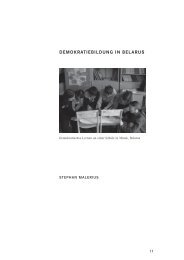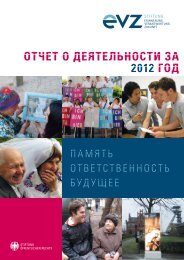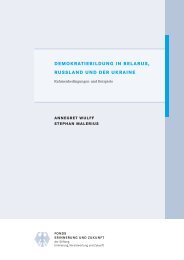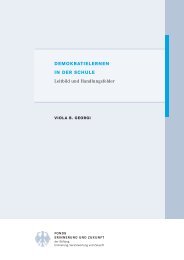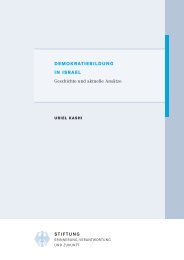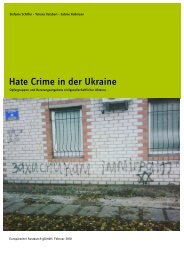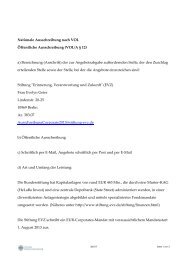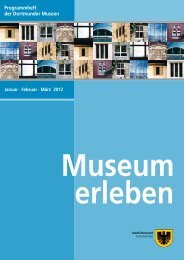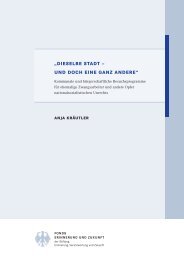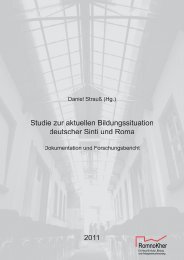chapter 2 - Stiftung "Erinnerung, Verantwortung und Zukunft"
chapter 2 - Stiftung "Erinnerung, Verantwortung und Zukunft"
chapter 2 - Stiftung "Erinnerung, Verantwortung und Zukunft"
You also want an ePaper? Increase the reach of your titles
YUMPU automatically turns print PDFs into web optimized ePapers that Google loves.
Patrice G. Poutrus<br />
The 1953 Asylum Ordinance<br />
Although the Basic Law was enacted in 1949, procedural rules governing the Federal Republic’s asylum law<br />
did not take effect until the Asylum Ordinance of January 1953. The initiative for drawing up binding regulations<br />
on asylum came from the Allied occupation authorities in West Germany, who had given clear signals<br />
to the federal government that it would be required to live up to its obligations <strong>und</strong>er the Basic Law. 6 In July<br />
1950, for example, the Allied High Commission instructed the German federal government to take in all foreign<br />
refugees who requested asylum at the border. 7 At that point, however, the admission of foreign refugees<br />
was at best a secondary priority for the Federal Republic, which was still focused on the needs of German<br />
refugees and expellees. 8 Hoping to forestall the Allied demand for new asylum regulations, the West German<br />
authorities claimed that the 1938 Police Decree on Foreigners, which still remained in effect after the war,<br />
was sufficient to address the right to asylum. In any case, the West German authorities argued that admitting<br />
large numbers of foreign refugees was not feasible because of the difficulties surro<strong>und</strong>ing the influx of German<br />
refugees. 9<br />
Despite its reluctance to divert resources to the issue of asylum, the ratification of the United Nations Convention<br />
Relating to the Status of Refugees (CRSR) in Geneva was a key foreign policy priority for West Germany.<br />
In their negotiations with the Allied High Commission, West German authorities therefore downplayed the<br />
constitutional right to asylum and instead emphasized that any future asylum ordinance would comply with<br />
the CRSR. The West German authorities acknowledged the CRSR would grant the United Nations High Commissioner<br />
for Refugees a voice in the Federal Republic’s refugee and asylum policies. 10 However, West German<br />
officials assumed that doing so would not require the repeal of the Police Decree on Foreigners, which<br />
included no specific provisions on asylum. Instead, the Police Decree on Foreigners granted local authorities<br />
broad discretion in granting residency permits, which had the desirable effect of preserving the primacy of<br />
domestic interests. This primacy is also apparent in the first section of the decree, which stated that foreigners<br />
would only be granted residency if their personality and reason for staying in West Germany “deserved<br />
hospitality.” 11 Under National Socialism, this formulation had justified the exclusion of foreigners on racial<br />
gro<strong>und</strong>s. In the early 1950s, the category of “deserving” foreigners could in theory be used to limit residency to<br />
persons who were deemed acceptable to the Federal Republic’s constitutional order, foreign policy interests,<br />
or demographic policies. In any case, the legal basis for asylum <strong>und</strong>er the 1938 decree was diametrically opposed<br />
to the right as it was formulated <strong>und</strong>er the Basic Law, which emphasized the subjective right to asylum<br />
on the basis of political persecution.<br />
In the early 1950s, a new and more expansive asylum policy still seemed a distant prospect. As a result of the<br />
negotiations with the Allies, however, the new asylum ordinance of 1953 made reference to the CRSR, which<br />
granted refugee status to foreigners who were persecuted for reasons of race, religion, or political opinion.<br />
6 Ulrich Herbert and Karin Hunn, “Beschäftigung, soziale Sicherung <strong>und</strong> soziale Integration von Ausländern,” in B<strong>und</strong>esministerium für Arbeit <strong>und</strong><br />
Soziales, Geschichte der Sozialpolitik in Deutschland seit 1945, vol. 3 (Baden-Baden, 2005): 788-790.<br />
7 Allied High Commission from July 14, 1950, “Admission and treatment of non-German refugees in the Federal Republic,” B<strong>und</strong>esarchiv Koblenz<br />
(BArch), B 106, No. 47453.<br />
8 Letter from the Federal Ministry of the Interior to the Federal Chancellery, Liaison Office to the Allied High Commission, dated Sep. 21, 1950, regarding<br />
a memorandum to the Allied High Commission of July 14, 1950 concerning the admission and treatment of non-German refugees in the Federal<br />
Republic, BArch, B 106, No. 47453.<br />
9 The Police Decree on Foreigners (Ausländerpolizeiverordnung, or APVO) was passed on Aug. 28, 1938. For a discussion of the West German government’s<br />
attitude toward German refugees, see Klaus J. Bade, Europa in Bewegung: Migration vom späten 18. Jahrh<strong>und</strong>ert bis zur Gegenwart (Munich, 2000): 284-305.<br />
See also the letter from the Liaison Office to the Allied High Commission to the Secretary-General Joseph E. Slater, dated Nov. 10, 1950, BArch, B 106,<br />
No. 47453.<br />
10 DBMdI (BMI), MR Kleberg, annotation to discussion with the refugee department of the AHC at Petersberg on Sep. 27, 1951, BArch, B 106, No. 47453.<br />
11 Berhard Santel and Albrecht Weber, “Zwischen Ausländerpolitik <strong>und</strong> Einwanderungspolitik. Migrations- <strong>und</strong> Ausländerrecht in Deutschland,” in Migrationsreport<br />
2000: Fakten, Analysen – Perspektiven, eds. Klaus. Bade and Rainer Münz (Bonn, 2000): 111.<br />
108<br />
<strong>Stiftung</strong> EVZ<br />
HUMAN RIGHTS AND HISTORY: A CHALLENGE FOR EDUCATION



